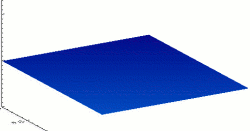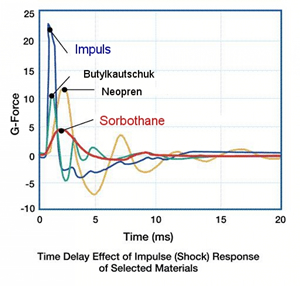|
In the following discussion of sound absorbers, we will demonstrate 1) Why absorbers are so important for good sound quality, 2) Which materials we prefer for these, 3) And what technology we use to achieve a convincing result. |
 |
- Technical Background
- Sorbothane©
- MLA - Multi Layer Adjustment
Loudspeakers make your system vibrate. This has a negative effect on the signals in the printed circuits, components and cables. Good vibration absorbers thus improve sound not only in mechanical devices such as turntables and CD players, but also in amplifiers and even power supply units
We shall also explain
1. Vibrations and their negative consequences: microphonics and mechanics
2. Types of vibration: ambient noise and mechanical vibrations
3. Tuning measures applied to your situation
1. Vibrations and their negative consequences?
Microphonics?
Microphonics is the scientifically proven effect that currents and signals disturbed by vibrations will be influenced negatively.
This is a law of physics and there is more on the subject on Wikipedia under “Microphonics”.
The outcome is an audibly more tentative and spatially less stable sound image.
Devices affected by this include: turntables, CD players, power supply units and amplifiers of all kinds.
Mechanical components
Vibrations reaching mechanical devices such as turntables and CD players have a deleterious influence on the sound,
as there is a negative effect on the pick-up abilities of the needle and the read quality of the CD laser.
As microphonics has an additional effect here, we have the best potential for optimisation with mechanical source devices.
We thus advise you to begin your vibration absorber tuning with your source devices.
Read more on this topic below – why does a CD player sound “harsh" and “unnatural”?
2. Types of vibration
The following examines which kinds of interference we should tell apart
Ambient noise
By this we mean the vibrations that travel through the air to the devices.
The cause of these are your loudspeakers, whose sound waves can cause a disturbance in your devices.
One thing that can be forgotten is the oft-quoted “footfall” – who walks through a room while they are listening
attentively to music?
Mechanical vibrations
By this we mean vibrations transmitted through solid objects.
In our case, these are vibrations whose effect on the devices is felt via the device support, i.e. the rack and
what is underneath it. The cause here is once again the loudspeakers, which transmit sound waves to their rack via the floor.
If you have unstable flooring such as laminate, tiles or floating parquet (not fixed with floor screed), you should de-couple
with absorbers rather than using spikes.
3. Tuning measures applied to your situation
What’s the best way for you to use absorber tuning?
Source devices?
We would first advise you to quieten your source devices (such as turntables and CD players) with vibration absorbers.
Even if we don’t have any mechanical vibrations caused by unstable flooring, this will allow us to simultaneously achieve an
optimisation of the read components and a reduction of the microphonics effect through a reduction in the ambient sound.
Amplifiers / valve (tube) amplifiers
Here we achieve a more stable and natural sound image through a reduction of mechanical vibrations and ambient noise.
We stock suitable absorbers for every weight class.
We have specially developed the 4TUBE series for valve amplifiers and their weak points.
Loudspeakers
If you have a laminate, tiled or floating parquet floor, we urgently advise you against using spikes.
Replace these with absorbers and thereby reduce mechanical vibrations.
Power supply units
As very high current flow in power supply units, the effect of vibration absorbers can often be heard here.
Definitely worth trying.
Why does a CD player sound “harsh" and “unnatural”?
With CD players, there is very common but unfortunately incorrect opinion that 1’s and 0’s are unambiguous and thus cannot be faked. This is true of computers, where protocols (TCP/IP etc.) assure correct transmission through repeated data readings where errors occur. A traditionally manufactured CD player has only one read procedure, however; re-reading is not practicable, as this would result in drop-outs in the music output. The correction bit on the CD only allows for the post hoc correction of certain kinds of faults and frequencies. If a CD player is disturbed by the sound from its loudspeakers, depending on the intensity of the vibrations, massive read errors are produced and these are only partially alleviated by the correction bit. This can often result in an “unnatural” or indeed “harsh” sound image.
Our vibration absorbers, using our own MLA technology, eliminate vibrations and thus read errors, by approx. 90%. The result is a natural sound image that you would never have expected from a CD.
Lots of customers have been convinced by our technology – feel free to read our client reviews on the subject.
Read Customer reportsSorbothane® is one of our favoured absorber materials. It is suitbale for all audio unit like
- Turntables
- CD-Player
- Pre-Amplifiers
- Amplifiers
-Loudspeakers

Sorbothane® is a proprietary, visco-elastic polymer. Visco-elastic means that a material exhibits properties of both liquids (viscous solutions) and solids (elastic materials).
Sorbothane combines shock absorption, good memory, vibration isolation and vibration damping characteristics. In addition, Sorbothane is a very effective acoustic damper and absorber. While many materials exhibit one of these characteristics, Sorbothane combines all of them in a stable material with a long fatigue life.
- Sorbothane has a low creep rate compared to other polymers (rubber, neoprene, silicone, etc.)
- Sorbothane has a superior damping coefficient, over a very wide temperature range, compared to any other polymer.
- Unlike fluid-based shock absorbers or foam products, Sorbothane absorbs shock efficiently for millions of cycles.
- Sorbothane eliminates the need for metal springs to return the system to its equilibrium position after absorbing a shock.
 Our Concept
Our Concept
Multi Layer: Some selective balanced Layers (Multi Layer) of different absorber materials:Sorbothane, cork, natural rubber etc.
Separated with an non-absorption Metal Layer.
Adjustment: Optimal adjustment to the weight of your audio unit
by different variants (Adjustment)
The Effectiveness
Each Absorber Layer provides filtering of different frequency ranges. Improved cumulative effect compared to single materials.




